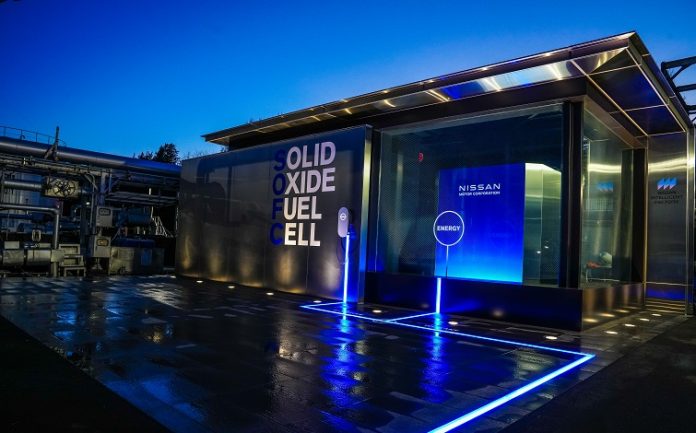YOKOHAMA, Japan – Nissan Motor Co. Ltd. today announced that it has developed a stationary, bio-ethanol-fueled system capable of high-efficiency power generation. Trials have begun at Nissan’s Tochigi Plant in Japan aimed to improve power generation capacity toward full-scale operations from 2030.
In 2016 Nissan became the first automotive company in the world to create a vehicular propulsion system powered by a solid oxide fuel cell (SOFC) run by bio-ethanol. Nissan is now applying this SOFC development experience to stationary power generation systems.
Features of SOFC
SOFCs can be easily paired with reformers that operate at high temperatures and can generate electricity using hydrogen obtained by reforming various types of fuels that react with oxygen, including ethanol, natural gas, and LP gas. Operations at high temperatures promote high catalytic activity, enabling the SOFC to achieve a high-power generation efficiency of 70%, compared to 60% for polymer electrolyte fuel cells (PEFCs).
Looking ahead, the development of a metal-supported cell, which is a component of the SOFC stack, will help to enhance cell strength. As a result, start-up and shutdown times can be shortened and load-following operations can be performed in response to sudden fluctuations in output demand. This will enable effective SOFC system operation in the future, when it is anticipated that the system will be used in conjunction with renewable energy.
Procurement of raw sorghum bio-ethanol
The stationary power generation system will be fueled by bio-ethanol produced from sorghum (sorghum bio-ethanol), which has been jointly developed with Binex Inc., with fuel being procured from Binex. This component will commence from 2025.
Although sorghum bio-ethanol emits CO2 during SOFC power generation, that CO2 is absorbed from the atmosphere during the sorghum growth process, contributing to the realization of a carbon neutral cycle where CO2 increases are effectively reduced to zero.
Characteristics of sorghum
1) Annual herbaceous plant of the grass family that grows quickly and can be harvested in about 3 months, enabling multiple harvests every year when grown in suitable conditions.
2) Given its adaptability to cold and dry regions, it can be grown in a wide range of regions and different soils.
3) The stem is used as a raw material for ethanol and the grain is used for food, meaning that there is no competition with food production.
4) Stem waste after pressing can also be used in biomass power generation.
Kazuhiko Murata, corporate vice president responsible for Powertrain Production Engineering and Development says: “There are major changes occurring in the transition from the internal combustion engine to electric vehicles. Nissan is taking up various technological development challenges in new areas, and SOFC power generation is one of our strengths. We will continue to contribute to the promotion of electrification and efforts toward carbon neutrality with Nissan-unique, innovative technologies.”
Nissan is committed to achieving carbon neutrality across the Company’s operations and product life cycle by 2050.
The goal is to fully electrify plant equipment by 2050 through the introduction of innovative production technologies and by reducing energy use. To achieve carbon neutrality at production plants, all electricity used will be generated from renewable energy sources or generated with onsite fuel cells that use alternative fuels.

